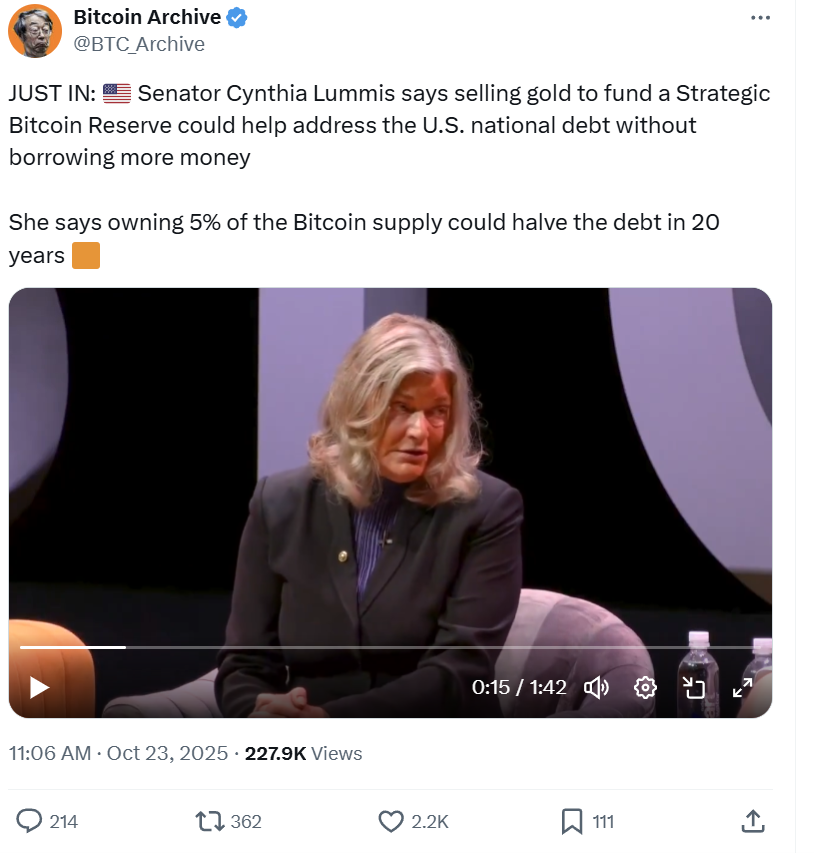Sen. Lummis: Bitcoin Could Slash U.S. Debt by 50%
 |
| By Bob Czeschin |
America’s national debt just topped $38 trillion.
Despite $350 billion in deficit reduction claimed by the Trump White House, total debt still rose another trillion in just 60 days.
And according to the unforgiving arithmetic of compound interest, debt service payments alone are on a path to $14 trillion over the next decade.

Because of this, Washington’s long-term solvency has never been a greater worry.
However, Wyoming Senator Cynthia Lummis says she has at least a partial solution: Use some of America’s gold hoard to buy Bitcoin (BTC, “A-”) … and put it in the “Strategic Bitcoin Reserve,” established by President Trump last March.
Doing this would bring three big benefits.
- Zero borrowing required. Because all this gold is already sitting in Fort Knox, spending it on Bitcoin requires no additional government borrowing.
-
Immediate 95x gain. The U.S. Treasury does not employ market-to-market accounting. Fort Knox gold is on the books at statutory value established by the Gold Reserve Act in 1973 — at just $42.22 per troy ounce.
That’s barely 1% of gold’s current market value (near $4,000). So, swapping for Bitcoin at today’s market price instantly unlocks a whopping 95x gain.
-
Supercharged reserve growth. Bitcoin is the best-performing major financial asset in the history of money.
Senator Lummis — drawing on work by Bitcoin evangelist Michael Saylor and economist Arthur Laffer — says that buying 1 million BTC with Fort Knox gold could effectively slash U.S. indebtedness 50%.

Of course, no one knows for sure Bitcoin will perform as well going forward as it has in the past. (It might do even better — as legions of investors worldwide flee a tottering financial system!)
But one thing is certain. Any time U.S. reserve assets appreciate — whether fast or slow — by definition, America becomes a less-leveraged borrower.
And that’s a good thing. Even if the recovery falls short of its 50% reduction goal.
Can It Work?
One way to assess the immense potential of appreciating reserve assets is to examine what happened to the Bitcoin seized by the United States in various criminal prosecutions.
White House Crypto Czar David Sacks says the U.S. previously held about 400,000 confiscated BTC before half was auctioned off for $366 million.
No “Strategic Reserve” existed back then. But had the government simply held on to those 200,000 BTC, today they would be worth a sizzling $22.6 billion.
That amounts to a whopping 61x gain … left on the table!
Other Central Banks Hold Bitcoin
Earlier this month, a Deutsche Bank study concluded that in just five years, global central banks will hold significant amounts of Bitcoin.
So far, however, only the Central Bank of El Salvador has admitted owning Bitcoin. The OG crypto makes up just under 10% of its reserve assets.
But a number of other countries are tiptoeing in this direction. For example:
- The French Parliament just took up a bill to authorize a national Bitcoin Strategic Reserve funded by 420,000 BTC, over seven to eight years. (By the way, this is direct defiance, of the European Central Bank, an implacable enemy of all things crypto.)
- Czech National Bank Governor Ales Michl recently announced the bank was formally considering Bitcoin as a reserve asset.
- Norway’s sovereign wealth fund already owns 2,446 BTC.
- The British government holds approximately 61,200 BTC.
- Both Bhutan and Ethiopia run Bitcoin mining operations that generate significant revenue and contributes to significant BTC balances.
If the U.S. accepts Senator Lummis’ proposal to swap Fort Knox gold for Bitcoin, it will surely cement Bitcoin’s status as a global reserve asset.
Plus, it would likely spark a FOMO-driven scramble among other central banks desperate not to be left behind.
And remember, central bankers buying Bitcoin … are very different from you and me: They’re not spending their own money. Which means they don’t care how much it costs.
Look, tariff-driven uncertainty, geopolitical risk and rising inflation have already lifted Bitcoin to multiple record highs in 2025.
But what better catalyst to keep this rally rolling … than a hefty bunch of big-foot, central bank bureaucrats spending other people’s money?
With the advent of crypto exchange-traded funds (ETFs), it’s never been easier for ordinary folks to buy Bitcoin … before the biggest players get on the blockchain.
Even so, if you’re relatively new to crypto, and welcome a little help getting started, check out Juan Villaverde’s Weiss Crypto Investor.
In it, he uses his Crypto Timing Model to help members maximize their potential gains on crypto’s biggest and best projects.
Best,
Bob Czeschin

